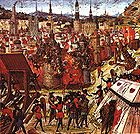
Letter of the Karaite elders of Ascalon
Encyclopedia

Ashkelon
Ashkelon is a coastal city in the South District of Israel on the Mediterranean coast, south of Tel Aviv, and north of the border with the Gaza Strip. The ancient seaport of Ashkelon dates back to the Neolithic Age...
and sent to their coreligionists in Alexandria
Alexandria
Alexandria is the second-largest city of Egypt, with a population of 4.1 million, extending about along the coast of the Mediterranean Sea in the north central part of the country; it is also the largest city lying directly on the Mediterranean coast. It is Egypt's largest seaport, serving...
nine months after the fall of Jerusalem
Siege of Jerusalem (1099)
The Siege of Jerusalem took place from June 7 to July 15, 1099 during the First Crusade. The Crusaders stormed and captured the city from Fatimid Egypt.-Background:...
during the First Crusade
First Crusade
The First Crusade was a military expedition by Western Christianity to regain the Holy Lands taken in the Muslim conquest of the Levant, ultimately resulting in the recapture of Jerusalem...
. The contents describe how the Ascalon elders pooled money together to pay the initial ransom for pockets of Jews and holy relics being held captive in Jerusalem by the Crusaders, the fate of some of these refugees after their release (including their transport to Alexandria, contraction of the plague
Bubonic plague
Plague is a deadly infectious disease that is caused by the enterobacteria Yersinia pestis, named after the French-Swiss bacteriologist Alexandre Yersin. Primarily carried by rodents and spread to humans via fleas, the disease is notorious throughout history, due to the unrivaled scale of death...
, or death at sea), and the need for additional funds for the rescuing of further captives. It was written in Judeo-Arabic, Arabic using the Hebrew alphabet
Hebrew alphabet
The Hebrew alphabet , known variously by scholars as the Jewish script, square script, block script, or more historically, the Assyrian script, is used in the writing of the Hebrew language, as well as other Jewish languages, most notably Yiddish, Ladino, and Judeo-Arabic. There have been two...
.
This and other such letters related to the Crusader conquest of Jerusalem were discovered by noted historian S.D. Goitein in 1952 among the papers of the Cairo Geniza
Cairo Geniza
The Cairo Geniza is a collection of almost 280,000 Jewish manuscript fragments found in the Genizah or storeroom of the Ben Ezra Synagogue in Fustat, presently Old Cairo, Egypt. Some additional fragments were found in the Basatin cemetery east of Old Cairo, and the collection includes a number of...
. Goitein first published his findings in Zion, a Hebrew journal, and then presented a partial English translation of the letter in the Journal of Jewish Studies that same year. Since then, it has been retranslated in several other books pertaining to the Crusades
Crusades
The Crusades were a series of religious wars, blessed by the Pope and the Catholic Church with the main goal of restoring Christian access to the holy places in and near Jerusalem...
. Goitein's final and most complete English translation appeared in his final book posthumously published in 1988.
External links
- University of Michigan. The letter based on Goitein's incomplete 1952 English translation (Internet ArchiveInternet ArchiveThe Internet Archive is a non-profit digital library with the stated mission of "universal access to all knowledge". It offers permanent storage and access to collections of digitized materials, including websites, music, moving images, and nearly 3 million public domain books. The Internet Archive...
). Retrieved 20-08-2007.

